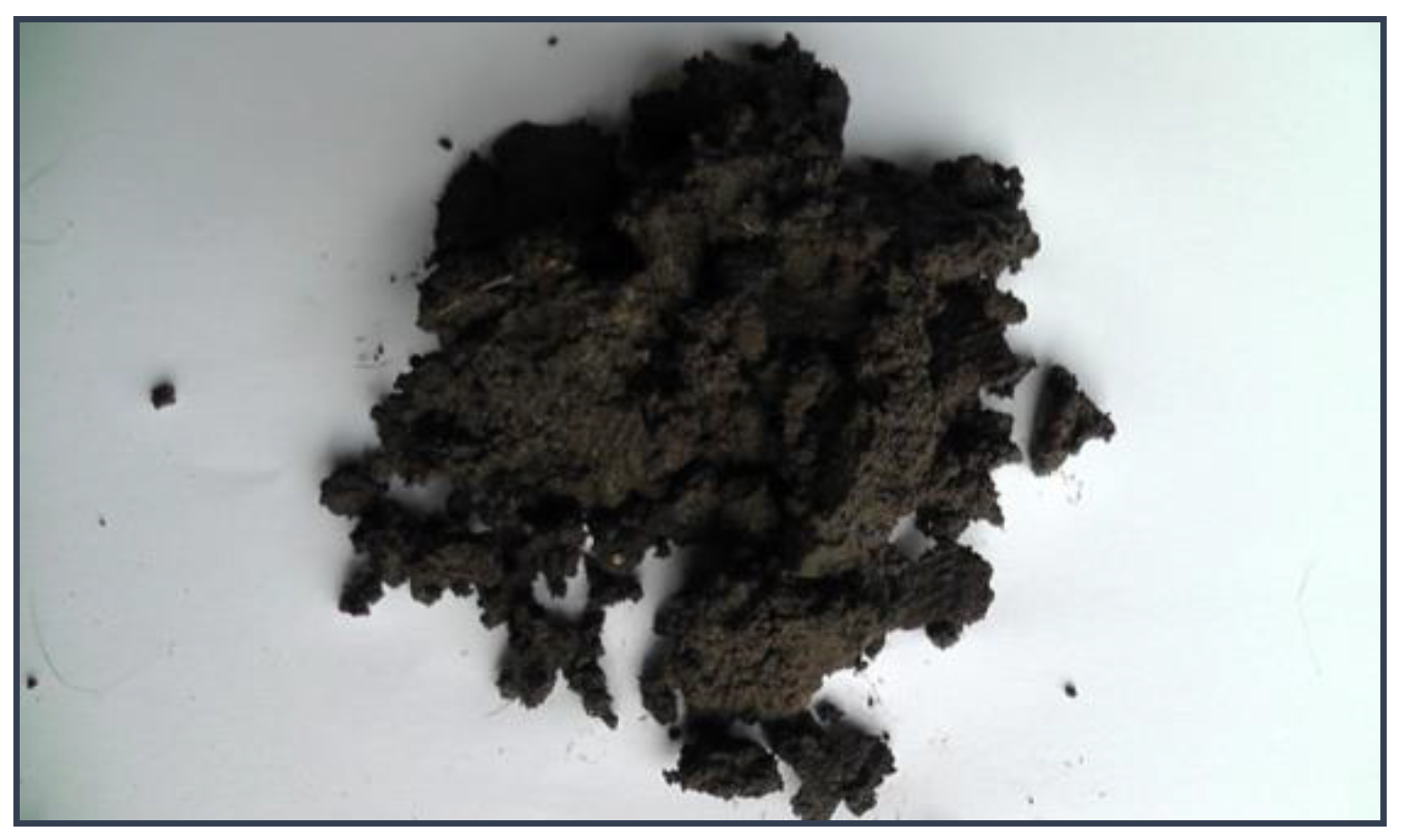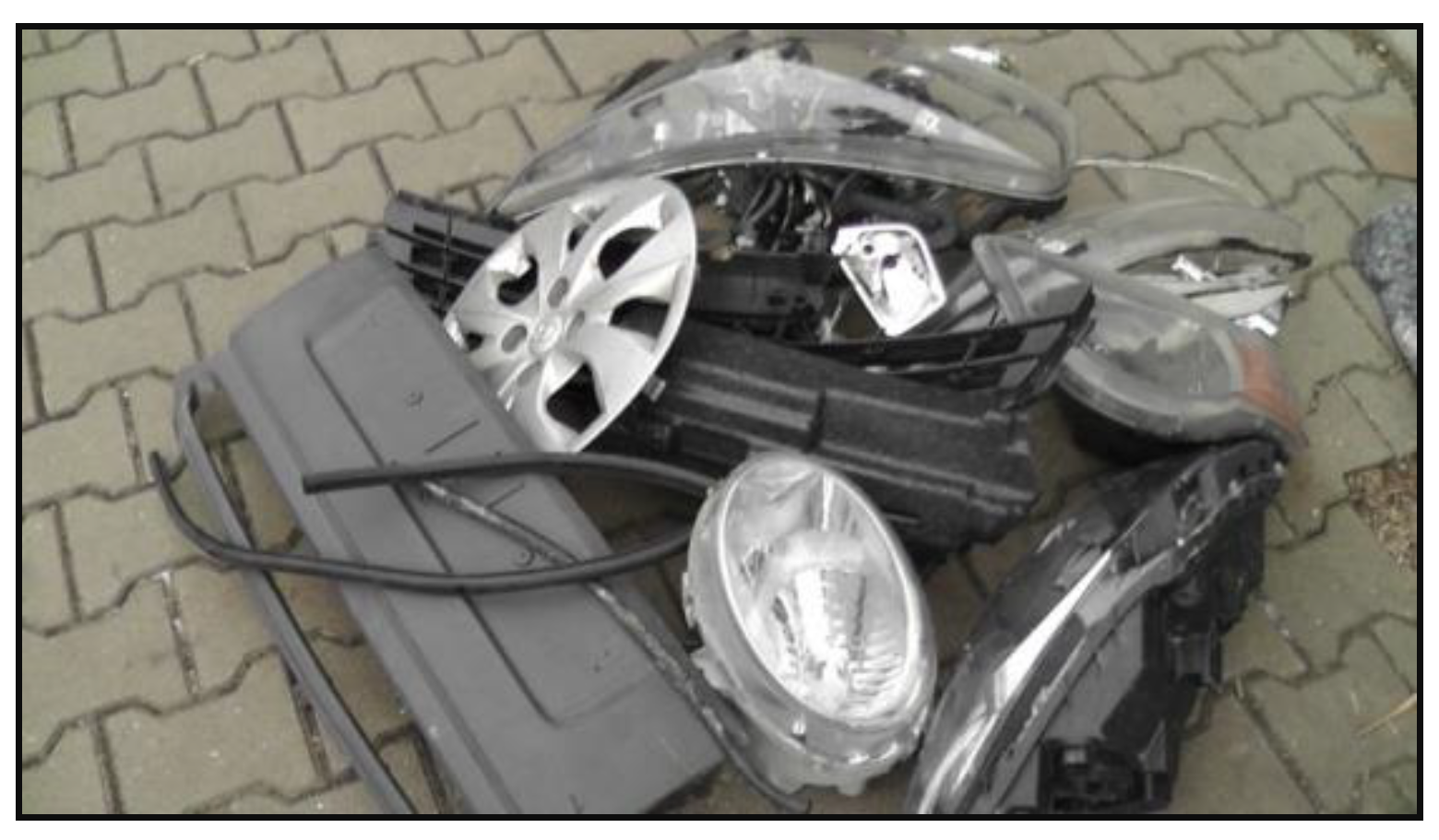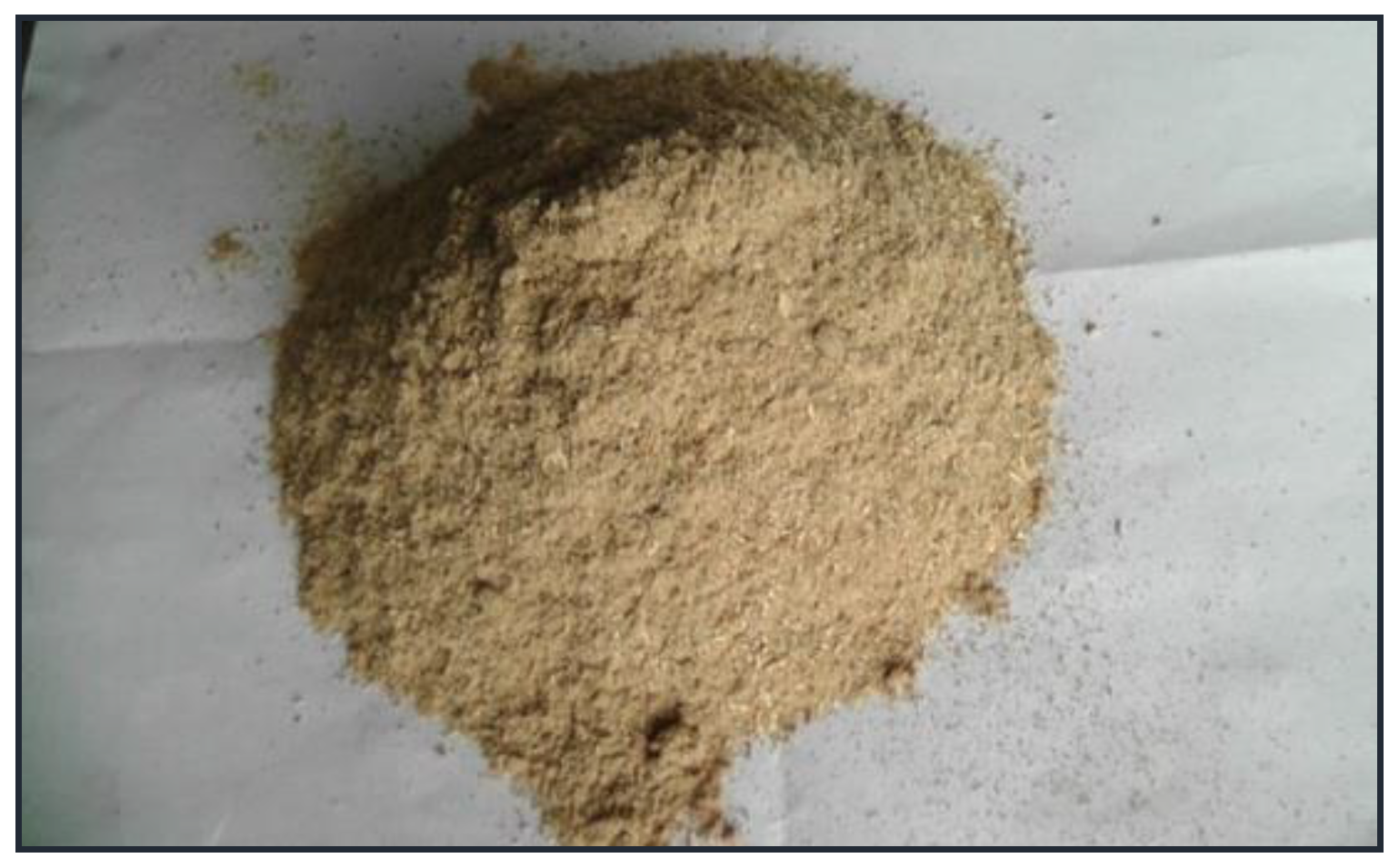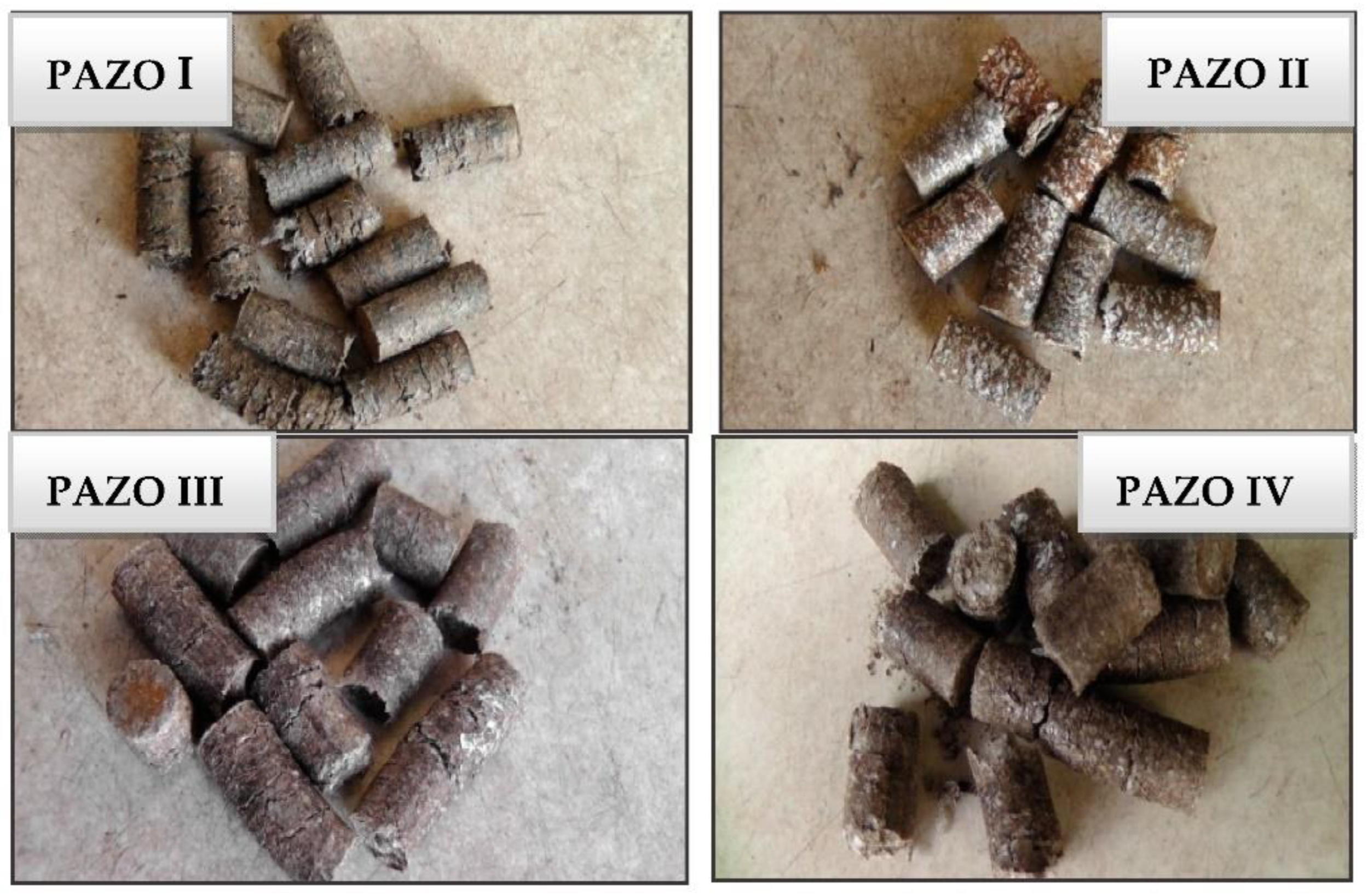1. Introduction
The dynamic development of sewage systems results not only from the need to improve the quality of life of the inhabitants but mainly from the need to ensure the quality of the natural environment and to meet the requirements of the national legislation on sewage management. The construction of new sewage systems and municipal wastewater treatment plants and the expansion and modernization of existing ones lead to an increase in the volume of sewage sludge generated [
1]. It is estimated in the National Waste Management Plan that the amount of municipal sewage sludge per dry matter will increase each year by ca. 2.5% [
2]. In Poland, data from Statistics Poland indicate that from 2000 to 2020, the total amount of municipal sewage sludge increased by about 58% [
3]. The production of municipal sewage sludge is not the purpose of wastewater treatment plant operation but it is a residue from the wastewater treatment process, being an integral part and a special category of waste [
1]. Sewage sludge is characterized by varying physical, chemical, and biological properties, with their variability depending on the type and composition of wastewater, concentration of pollutants in the wastewater that flows into the treatment plant, and technologies of wastewater and sludge treatment [
4]. Municipal sewage sludge exhibits a significant proportion of organic and mineral matter, high water content, and the ability to rot. Furthermore, it contains heavy metals or toxic substances, i.e., polycyclic aromatic hydrocarbons (PAHs), polychlorinated biphenyls (PCBs), and dioxins [
5]. The composition of municipal sewage sludge includes both microorganisms that are neutral for sanitation and pathogenic microorganisms that pose a threat to humans and the environment [
6]. Therefore, taking into account the composition and properties of sewage sludge, its significant impact, and the risks it may pose to human health and the environment, it is necessary to employ appropriate methods for sewage sludge treatment and subsequent management.
The large increase in the amount of generated municipal sewage sludge creates a problem with its management [
1]. Sewage sludge accounts for about 3% of the volume of treated wastewater, and the cost of appropriate treatment and management that meets environmental requirements can be as much as half of the operating costs of wastewater treatment plants [
7]. Municipal sewage sludge is subject to the national acts on waste and the EU Waste Framework Directive from the time it becomes waste. As it meets the definition of waste, it is subject to all regulations for treatment and final waste management. It is subject to the waste management hierarchy, which emphasizes the pursuit of waste prevention or reuse at the point of waste generation after appropriate preparation as the highest priority [
1]. Another method of managing municipal sewage sludge is recycling and other recovery processes, such as energy recovery. In the waste management hierarchy, methods such as incineration and landfilling should be used last. The methods of municipal sewage sludge management in Poland are largely determined by legal requirements resulting from the country′s membership in the European Union [
8]. The National Waste Management Plan, which coordinates the implementation of EU commitments adopted by Poland on the management of municipal sewage sludge, sets targets for sludge treatment and management [
1]. The plan assumes a complete cessation of landfilling of municipal sewage sludge [
9], an increase in the amount of sludge recovered in composting or biogas plants and its direct use in soil, and an increase in the amount of sludge subjected to thermal processing in waste incineration or co-incineration plants (including cement plants) [
1].
Currently, the most frequently used form of municipal sewage sludge management is its agricultural and natural use [
10]. On the one hand, the use of municipal sewage sludge as a fertilizer has a positive impact on the environment, but, on the other hand, it can also have a negative effect on people and soil productivity [
11,
12,
13,
14]. According to Statistics Poland, the country is also seeing an increase in the use of thermal methods of municipal sewage sludge management. In 2020, more than six times the amount of municipal sewage sludge was transformed using these methods compared to 2010. However, a decrease was found in the use of municipal sewage sludge in agriculture and growing crops for compost production [
3]. Municipal sewage sludge has soil-forming properties when it has a high content of organic matter, micronutrients, and biogenic compounds. Unfortunately, increasing requirements to meet sanitary and chemical safety conditions set by legislation are reducing their use for land reclamation for agricultural purposes. Therefore, the issue of both the high content of heavy metals in municipal sewage sludge and the presence of pathogenic microorganisms becomes a significant problem [
8]. Harmful substances, including heavy metals, entering the soil in excessive amounts can cause an increase in soil pollution. They migrate to groundwater and accumulate contaminants in plants consumed by animals and humans [
7]. Therefore, when discharging municipal sewage sludge into the environment, it is advisable not only to consider the content of chemical pollutants and ecotoxicity, but also to estimate its effect on microorganisms, vegetation, and animals [
5].
The environmental and agricultural use of sewage sludge [
8], despite the fact that it is permitted after meeting certain legal requirements regarding the content of pathogenic microorganisms and toxic substances, is still a controversial issue in European countries [
15]. Thermal methods may be an alternative to the agricultural use of sewage sludge, but they should ensure optimal utilization of the energy it contains [
16]. An important property of municipal sewage sludge in this regard is its calorific value, which is determined by the degree of dryness. Moreover, the content of organic dry matter determines the calorific value of sewage sludge. With relevant regulations, the cement industry allows dried sewage sludge to be used for energy generation. Co-combustion of sludge can be used in clinker kilns because, as an energy source that is neutral to CO
2 emissions, it reduces the associated additional costs [
1]. In clinker production, there is the possibility of using alternative fuels based on municipal sewage sludge. This is a solution that allows sewage sludge to burn safely and helps reduce CO
2 and NO
x emissions into the atmosphere. Furthermore, in economic terms, it combines the effects of recovering waste materials from other industries and the preservation of natural resources and fossil fuels [
17].
A waste raw material that can also be used as a component of alternative fuels burned in cement furnaces is plastic waste from the dismantling of end-of-life vehicles (ELVs).
The continuous development of the automotive industry is affecting the number of vehicles present on the roads. It should be noted that motor vehicles are the most common means of transportation used in most areas of the economy and in most households, especially in small towns [
18]. Demand for used cars is also on the rise while interest in them is mainly driven by economic aspects. Cars are therefore a product used extensively by humans, diverse in age and condition [
19]. Many of them end their useful life and become end-of-life vehicles, which in turn generate waste [
20]. Today, the automotive industry is replacing, to a greater extent, a percentage of steel or cast iron components with plastic materials that reduce the vehicle′s weight [
21]. The reduction of harmful emissions into the environment and compliance with the EURO standards indirectly require a higher proportion of plastics in the vehicle weight. A 100 kg reduction in vehicle weight results in a 7.5 g/km reduction in CO
2 emissions and a 0.3 to 0.5 l/100km reduction in fuel consumption [
22]. Plastics account for ca. 21% of the materials making up the vehicle weight. These data allow for the estimation of the amount of waste plastics to be managed [
23]. The solution to this problem can be to exploit the energy potential of plastic waste by producing alternative fuels.
Another type of waste characterized by energy potential is wood waste. The development of the timber industry has led to an increase in the volume of wood waste in furniture factories, particle board manufacturing, and the pulp industry, but the largest amount is generated in the sawmill industry. Sawmill waste, despite its high variability, shows high purity, so it is suitable for reprocessing and use as fuel in the power industry. In contrast, the wood waste generated in wood processing plants is a byproduct resulting from the technological processes used in wood processing and poses a major management problem [
24]. The waste created during mechanical processing such as cutting, milling, planing, drilling, turning, sanding, or polishing of wood or furniture boards is used in the construction industry in the form of wood chips and sawdust for the manufacture of various construction products. In agriculture, sawdust waste is used as fertilizer and bedding in animal husbandry, and chip waste is used in horticulture as fertilizer for growing plants. Another example of the use of wood waste is energy production. The waste, which is the residue from logging and wood processing (accounting for up to 27% of the weight of wood), can be extracted in an amount of up to precisely 42% for energy purposes, due to its corresponding calorific value ranging from 18.5 MJ/kg up to 20 MJ/kg [
25].
The aim of the present study is to present an innovative method to produce alternative fuels under laboratory conditions based on municipal sewage sludge, plastic waste from end-of-life vehicles, and wood waste without pre-drying or drying of municipal sewage sludge, which meet the requirements for fuels used in the cement industry. The developed method of fuel production allows for the management of municipal sewage sludge with low calorific value and various types of waste and offers the opportunity to use new alternative fuels as a substitute for conventional raw materials used in the cement industry.
3. Results and Discussion
The results of the technical analysis obtained for water, volatile matter, and ash contents, elemental analysis for carbon, hydrogen, sulfur, and chlorine contents, and determination of the calorific value of municipal sewage sludge, plastic waste, and wood waste (sawdust) are shown in
Table 5,
Table 6 and
Table 7, respectively.
Based on the evaluated properties, significant differences were found in their calorific value. It is the most basic and most important parameter that determines the possibility of using waste, including municipal sewage sludge used as fuel [
33]. The calorific value significantly depends on the content of combustible components, ash, and water content [
34]. The calorific value was 16.85 MJ/kg for wood waste (sawdust) and ranged from 21.57 MJ/kg to 52.05 MJ/kg for individual types of plastic waste. The varying results in the calorific value of PP, PET, PC, and PE waste were due to the variability in water content. The calorific value of municipal sewage sludge was very low (0.89 MJ/kg) compared to the other types of waste. The tested sewage sludge exhibited high water content of 80.22%, and such a low value resulted in a correspondingly lower calorific value.The calorific value of sewage sludge with such high water content is very low and does not indicate the possibility of using the sludge as fuel. Sewage sludge dewatered to 50% dry matter and containing 50% organic matter has a calorific value of 4 MJ/kg, while sludge dewatered to 50% dry matter and containing 75% organic matter has a calorific value of 6.5 MJ/kg. A possibility for dewatering sludge for use as an alternative fuel in the cement industry is to mix it with other waste [
35]. This solution helps to simultaneously increase the calorific value of the obtained fuel and manage different types of waste.
In addition to water content, another parameter that affects the ignition process of a combustible substance is ash content [
34]. Based on the test results presented in
Table 5,
Table 6 and
Table 7, it was found that municipal sewage sludge had ash content of 33.54%, which was higher compared to its value for wood waste (sawdust) (0.92%), and PP, PC, and PE waste (0.3% to 1%). Only PET plastic waste had an ash value of 22.95%, which was significantly higher and approached the value for municipal sewage sludge. Therefore, it should be noted that the high ash content of sewage sludge and PET waste can reduce the calorific value of the fuels produced from them, thus affecting the combustion process. The proportion of volatile matter in fuels also determines the course of its combustion process since fuels with low volatile content are more difficult to ignite [
36].The tests showed high content of volatile matter both in plastic waste (76.95% to 99.60%) and wood waste (sawdust) (93.55%). In contrast, the volatile content for municipal sewage sludge was 59.75%. The results obtained from the elemental analysis of municipal sewage sludge, PP, PET, PC, and PE waste, and wood waste indicate carbon content of 30.50% for sewage sludge, varying levels from 41.37% to 68.15% for plastics, and 55.08% for wood waste. Carbon content affects the amount of heat released during the combustion process [
36]. Chlorine and sulfur are parameters whose levels should be negligible due to their corrosive effects [
34]. The sulfur content of the sewage sludge was higher compared to other types of waste tested (1.36%). For the remaining types of waste, the sulfur content was below 1%, and for PET, PC, and PE waste, the results indicated no sulfur content. Furthermore, the proportion of chlorine in the study was 1.26% for PET waste and between 0.02% and 0.09% for other types of plastic waste. The sulfur content of the sludge analyzed was 0.08%, whereas that of wood waste (sawdust) was 0.06%.
During the analysis of the results of the tests on the properties of municipal sewage sludge, PP, PET, PC, and PE waste, and wood waste (sawdust), their percentage contents in the obtained alternative fuel mixtures (PAZO I, PAZO II, PAZO III, and PAZO IV) were computed.Based on the relatively low calorific value of sewage sludge and its high water content, as well as the high calorific value and volatile content of the remaining waste, an attempt was made to mix them and create an alternative fuel for use in the cement industry. The assumption of the study remained the same: municipal sewage sludge would be used without pre-drying or drying. According to the literature [
37,
38,
39,
40], only dried municipal sewage sludge is used as a component of alternative fuels with other materials. It is characterized by a higher calorific value of 14 MJ/kg [
33,
38,
40]. Drying sewage sludge reduces the water content of the sludge and increases its calorific value. It prepares the sludge for further use by reducing its weight and volume [
41]. Thermal drying of sewage sludge is a costly process because it consumes significant amounts of heat. The demand for energy, whose sources include gas and oil, for example, grows as the sludge becomes more hydrated [
42].
A prerequisite for the use of alternative fuels in cement plants is that they meet the following quality criteria: calorific value ≥21 MJ/kg, water content ≤20%, ash content <20%, sulfur content <0.5%, and chlorine content ≤0.8% [
43]. Analysis of the results of Tests I, II, III, and IV of the basic fuel parameters of the obtained PAZO I, PAZO II, PAZO III, and PAZO IV fuels presented in
Table 8,
Table 9,
Table 10 and
Table 11 revealed that the water content of the fuel mixtures ranged from 17.10% to 41.47%, and was much lower than for municipal sewage sludge (80.22%).
The water content results of the PAZO I, PAZO II, PAZO III, and PAZO IV fuel mixtures at 50% municipal sewage sludge (SS), 25% wood waste (WW), and 25% plastic waste (PW) obtained in Test I ranged from 41.47% to 39.81%. Analysis of the results of Tests II, III, and IV found a further significant decrease in the water content of PAZO I, PAZO II, PAZO III, and PAZO IV. The lowest values, ranging from 17.10% to 19.22%, were obtained for the proportions of 25% SS, 25% WW, and 50% PW in Test IV. The results indicated that mixing hydrated municipal sewage sludge with waste that had lower moisture content yielded fuel mixtures with 50% lower water content in Test IV than in Test I.
Significant differences were also observed in the ash and volatile contents of PAZO I, PAZO II, PAZO III, and PAZO IV fuels compared to their values for municipal sewage sludge.The varying composition of the mixtures led to much lower ash content of between 4.60% and 18.20% in all tests compared to its level for SS (33.54%). The results obtained in Test IV indicated the lowest ash content in PAZO I, PAZO III, and PAZO IV fuels (2.5% to 3.40%), while the ash content in the PAZO II fuel mixture with PET waste was higher (17.60%). High volatile content ranging from 79.05% to 96.90% was obtained in Tests I, II, III, and IV of PAZO I, PAZO II, PAZO III, and PAZO IV fuels and was significantly higher compared to SS (59.75%).
The calorific value of PAZO I, PAZO II, PAZO III, and PAZO IV fuels in Tests I, II, III, and IV was another parameter that indicated their potential for use in the cement industry. All fuel mixtures had higher calorific values, ranging from 10.41 MJ/kg to 33.40 MJ/kg, compared to SS (0.89 MJ/kg). In Test IV, PAZO I fuel mixtures with the addition of PP and PAZO IV with the addition of PE obtained the highest calorific value of 32.47 MJ/kg and 33.40 MJ/kg, respectively, similar to the level for hard coal (24 MJ/kg–28 MJ/kg). The results obtained for the other fuel parameters confirmed their potential for generating energy in the cement industry. The calorific value of alternative fuels depends on the contents of their components. PAZO I, PAZO II, PAZO III, and PAZO IV fuels showed high heating values compared to other fuels reported in the literature. Smoliński et al. [
44] obtained a fuel based on sewage sludge and coal waste with a calorific value of 14 MJ/kg to 18 MJ/kg, whereas Chen et al. [
45] obtained fuel from sewage sludge and wood dust with a calorific value of 21 MJ/kg to 23 MJ/kg.
The requirements contained in EN ISO 21640:2021 “Solid secondary fuels: Specifications and classes” for alternative fuels divide fuels into classes. The lowest calorific value of the fuel should not exceed 3 MJ/kg (Class 5) [
46]. The hydrated municipal sewage sludge used in the study had too low a calorific value to be included in Class 5. The alternative fuels obtained in Test IV had the heating value required for Class I (≥20 MJ/kg) for PAZO I (32.47 MJ/kg) and PAZO IV (33.40 MJ/kg), with a 25% proportion of municipal sewage sludge in the fuels.











